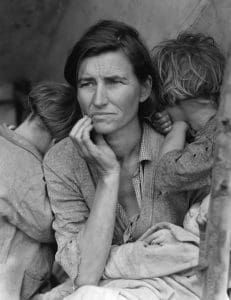The life of trailblazing documentary photographer Dorothea Lange, best known for the Depression era portrait, Migrant Mother, inspired not one but two recent novels, Learning to See by Elise Hooper and The Bohemians by Jasmin Darznik. On top of that, novelist Kristin Hannah has said that her latest bestselling novel, The Four Winds, was partially inspired by Lange's photographs of strong, resilient women.
Want to learn more about the woman behind the camera and her era-defining photographs? Check out these books.
Lange initially found success photographing California’s wealthy residents. But during the height of the Depression, she felt “the discrepancy between what I was working on . . . and what was going on in the street.” When a bread line formed not far from her studio, she was moved to photograph an elderly man at the back of the crowd, leaning on a fence.
Entitled White Angel Breadline, San Francisco (1933), this haunting photo marked a new direction for Lange: it was the first of thousands of photos she took of victims of the Great Depression. It’s also the first photo in Mark Durden’s splendid book, Dorothea Lange, which presents select photos in chronological order, each captioned with background on the subjects or the photo shoot.
Her most famous photo, Migrant Mother, was taken in 1936 at a pea picking camp when Lange worked for the Farm Security Administration, a government agency created to document and aid impoverished rural Americans during the Great Depression. This powerful photo of a careworn mother graces the cover of Milton Meltzer's Dorothea Lange: A Photographer's Life, a biography informed by the author’s use of Lange’s journals and letters, as well as interviews with the photographer and her associates.
A more recent biography of Lange and one that underscores her status as a woman photographer in a male-dominated field is Dorothea Lange: A Life Beyond Limits. Feminist historian and writer Linda Gordon takes readers from Lange’s polio-stricken youth through her two marriages and, of course, her remarkable career in which she documented subjects that others shied away from.
Among Lange’s most haunting images are those that document a shameful chapter of American history: the imprisonment of Japanese Americans following Japan’s 1941 attack on Pearl Harbor. Although Lange was hired by the U.S. government to document the evacuation and imprisonment of over 110,000 men, women and children, her empathetic photos were later suppressed by the government until the war was over. Impounded: Dorothea Lange and the Censored Images of the Japanese American Internment collects Lange’s photographs from this period, including heartbreaking shots of puzzled children awaiting evacuation and upon arrival at internment camps.
Lange's career spanned forty years, and Dorothea Lange: Photographs From the J. Paul Getty Museum offers a nice mix of her work, from a lovely shot of her first husband and their newborn son to her portraits of women in headscarves from her trips abroad.
Do you have a favorite Dorothea Lange photo? Mine is of a grandfather teaching his grandson to walk against the eerie landscape of an internment camp.



Add a comment to: Dorothea Lange: The Woman Behind the Lens